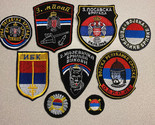REPUBLIC SRPSKA ARMY, GROUPING OF 9 PATCHES, CIRCA 1992-1995, VINTAGE, WARTIME
From Left to Right, Top Row:
PATCH REPUBLIC SRPSKA ARMY, 3rd POSAVINA SERBIAN BRIGADE, PATCH, CIRCA 1992-1995
REPUBLIC SRPSKA ARMY, 3rd MILITARY POLICE, ANTI-TERRORIST UNIT, OBILIC, PATCH, CIRCA 1992-1995
REPUBLIC SRPSKA ARMY, 2nd MAJEVICA WOLVES, PATCH, CIRCA 1992-1995
PATCH REPUBLIC SRPSKA ARMY, ENLISTED CAP PATCH, CIRCA 1992-1995
From Left to Right, Bottom Row:
PATCH REPUBLIC SRPSKA ARMY, SHOULDER PATCH, CIRCA 1992-1995
PATCH REPUBLIC SRPSKA ARMY, 3rd MIXED ANTI TANK, PATCH, CIRCA 1992-1995
PATCH REPUBLIC SRPSKA ARMY, 3rd CORPS, PATCH, CIRCA 1992-1995
REPUBLIC SRPSKA ARMY, 1st POSAVINA SERBIAN BRIGADE, CIRCA 1992-1995
PATCH REPUBLIC SRPSKA ARMY, OFFICER CAP PATCH, CIRCA 1992-1995
These Serbian patches are bring backs from a U.S. Special
Forces team that was deployed to Br?ko during the Bosnian War. Patches of
Republic of Srpska and the Republic of Serbian Krajina are extremely scarce.
Br?ko was a geographic point of contention in 1996 when the U.S.-led
Implementation Forces (IFOR) built Camp McGovern on the outskirts of the city.
Camp McGovern was built in the ZOS for the purpose of establishing peacekeeping
operations, specifically between Muslims in
Gornji Rahi? near Brka and Serbs in Br?ko.
The initial US Army unit to deploy into Br?ko was Task Force 3-5 CAV, a Task
Force composed of individual units of the 1st Armored Division. The commander
of Task Force 3-5 was LTC Anthony Cucolo. The Task Force headquarters was located
at Camp McGovern.
The Bosnian War or the War in Bosnia and Herzegovina was an international armed
conflict that took place in Bosnia and Herzegovina between April 1992 and
December 1995. The war involved several sides. The main belligerents were the attacking
forces of the self-proclaimed Bosnian Serb and Bosnian Croat entities within
Bosnia and Herzegovina, the Republika Srpska and Herzeg-Bosnia, who were led
and supplied by Serbia and Croatia respectively, and the Republic of Bosnia and
Herzegovina.
The war came about as a result of the breakup of Yugoslavia. Following the
Slovenian and Croatian secessions from the Socialist Federal Republic of
Yugoslavia in 1991, the multi-ethnic Socialist Republic of Bosnia and
Herzegovina, which was inhabited by Muslim Bosniaks
(44 percent), Orthodox Serbs (31 percent) and Catholic Croats (17 percent),
passed a referendum for independence on 29 February 1992. This was rejected by
the political representatives of the Bosnian Serbs, who had boycotted the
referendum and established their own republic.
Following the declaration of independence, the Bosnian Serbs, supported by the
Serbian government of Slobodan Milo?evi? and the Yugoslav People's Army (JNA),
mobilized their forces inside the Republic of Bosnia and Herzegovina in order
to secure Serbian territory and war soon broke out across the country,
accompanied by the ethnic cleansing of the Bosniak population, especially in
Eastern Bosnia.
It was principally a territorial conflict, initially between the Serb forces
mostly organized in the Army of Republika Srpska (VRS) on the one side, and the
Army of the Republic of Bosnia and Herzegovina (ARBiH) which was largely
composed of Bosniaks, and the Croat forces in the Croatian Defence Council
(HVO) on the other side. The Croats also aimed at securing parts of Bosnia and
Herzegovina as Croatian. The Serb and Croat political leadership agreed on a
partition of Bosnia with the Kara?or?evo and Graz agreements, resulting in the
Croat forces
turning on the Army of the Republic of Bosnia and Herzegovina and the
Croat-Bosniak war. The war was characterized by bitter fighting, indiscriminate
shelling of cities and towns, ethnic cleansing and systematic mass rape, mostly
led by Serb and, to a lesser extent, Croat
forces. Events such as the Siege of Sarajevo and the Srebrenica massacre would
become iconic of the conflict.
The Serbs, although initially superior due to the vast amount of weapons and
resources provided by the JNA, eventually lost momentum as the Bosniaks and
Croats allied themselves against the Republika Srpska in 1994 with the creation
of the Federation of Bosnia and
Herzegovina following the Washington agreement. After the Srebrenica and
Markale massacres, NATO intervened during the 1995 Operation Deliberate Force
against the positions of the Army of Republika Srpska, which proved key in
ending the war. The war was brought to an end after the signing of the General
Framework Agreement for Peace in Bosnia and Herzegovina in Paris on 14 December
1995. Peace negotiations were held in Dayton, Ohio, and were finalized on 21
December 1995. The accords are now known as the Dayton Agreement. A 1995 report
by the Central Intelligence Agency found that Bosnian Serb forces were
responsible for 90% of the war crimes committed during the conflict. As of
early 2008, the International Criminal Tribunal for the former Yugoslavia had
convicted 45 Serbs, 12 Croats and 4 Bosniaks of war crimes in connection with
the war in Bosnia. The most recent research places the number of people killed
at around 100,000?110,000 and the number of people displaced at over 2.2
million, making it the most devastating conflict in Europe since the end of
World War II.
Although Br?ko was a focal point for tension in the late 1990s, considerable
progress in multi-ethnic integration in Br?ko has since occurred including
integration of secondary schooling. Reconstruction efforts and the Property Law
Implementation Plan have improved the situation regarding property and return.
International Buyers Please Note: We do not ship outside of the United States! No Exceptions. In addition, we will not ship to third party shippers or any other international shipping hubs such as International Shipping (EIS), EIS 110 INTERNATIONALE BLVD, GLENDALE HEIGHTS IL 60139-2080. If you place a bid, or make a purchase, we will cancel your bid, and or cancel your purchase! If you wish to make a purchase, you will have to find someone located within the United States to make the purchase for you. They would be responsible to send the package to you.
